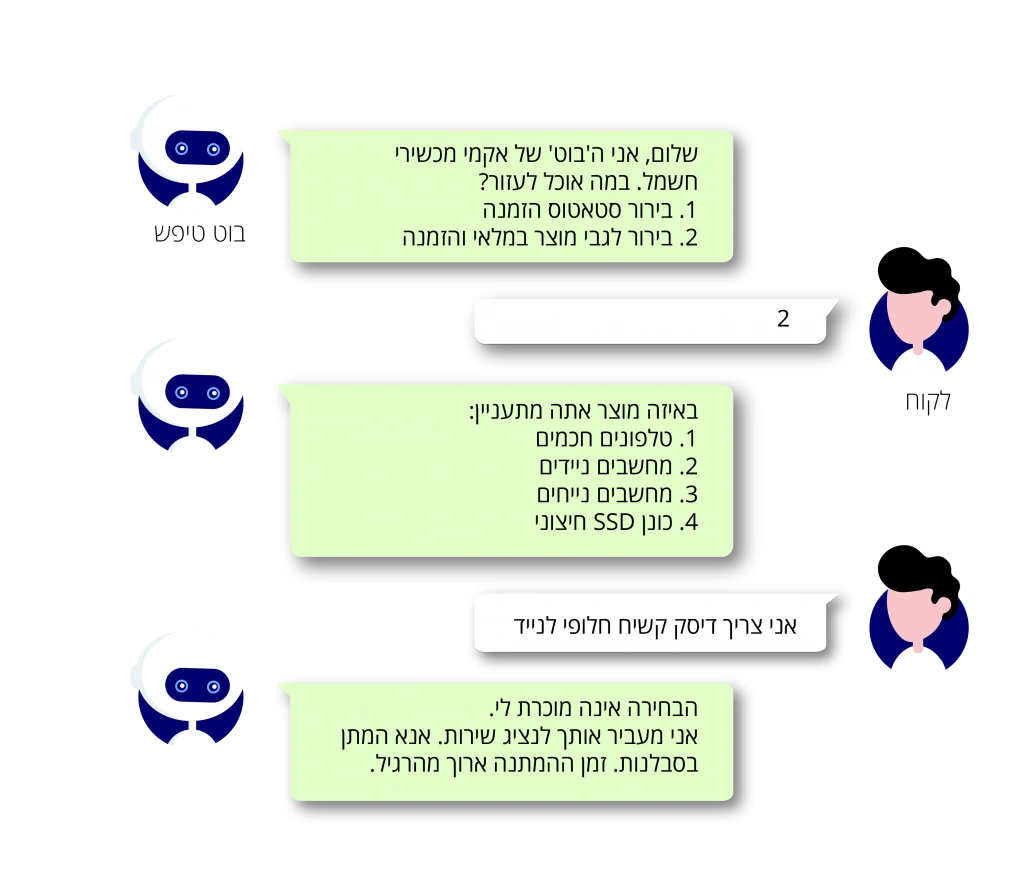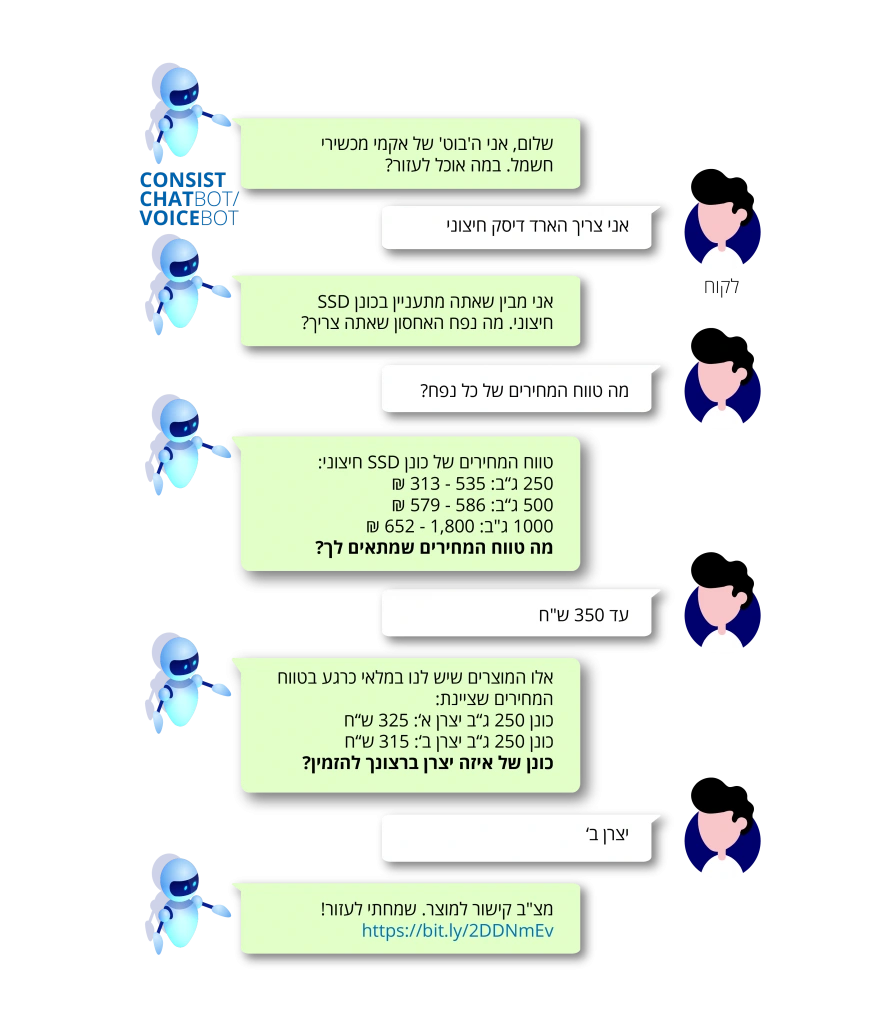In today’s digital age, customers seek maximum convenience, speed, and efficiency when using products and services. It’s no surprise, then, that bots are becoming a preferred solution for many organizations aiming to provide the most immediate and effective service to their clients. A well-designed smart bot can streamline multiple operational areas within an organization, such as customer service, sales, and technical support, while significantly reducing customer wait times for human agents.
The adoption of bots is rapidly accelerating. Unlike human agents, bots can operate 24/7/365, providing service and selling around the clock. As a result, they have become a central tool in the service, sales, and support operations of leading companies worldwide.
The potential of smart bots is immense, and implementing such a solution can bring substantial benefits to a wide range of organizations, both large and small.
What exactly is a “bot”?
A bot is a conversational interface—voice-based, text-based, or a combination of both—designed to handle customer inquiries with the goal of streamlining customer service, sales, and support processes. A bot allows customers to access services and perform various tasks such as checking order status, scheduling appointments, obtaining information about products and services, making online purchases, locating a professional or service provider, completing digital forms, and more—all automatically, without needing to wait for or interact with a human agent, either by voice or text.
A well-functioning bot can seamlessly answer questions, respond to customer commands, and guide them, with interactions taking place either through written or spoken conversation. Consist’s bot is capable of providing all these features in multiple languages, including Hebrew.
The difference between a “regular” bot and ConsistAI: Artificial Intelligence makes all the difference.
Artificial Intelligence changes the way bots conduct dialogues with customers and how effectively a bot can support them.
Most bots today—like those found on many websites—can only answer very specific, predefined questions or recognize a set of keywords. Such a bot is called a SEQUENTIAL BOT. It asks closed-ended questions with a limited number of choices for the customer and advances the process based on the customer’s responses—either by voice or text—following a script predetermined by the process creator.
A “dumb” bot like this can only follow the set script precisely, and any deviation by the customer usually causes the dialogue to stall, creating the need to transfer the conversation to a human agent.
Example of a dialogue between a “dumb” bot and a customer:

A smart bot operates like a proactive service agent or a skilled sales representative!
Unlike a “dumb” bot, which can only follow a fixed, closed script, a smart bot is able to create connections between different pieces of information provided by the customer to respond in the most appropriate way—even when the customer’s answers do not fully match the predefined script.
A smart bot also uses natural language processing, voice recognition, automatic speech recognition, and AI-driven analysis of questions and intentions to create a better service experience for the customer.
Such a smart bot can also store user information, learn to recognize patterns in the data it receives, make decisions, and guide the dialogue using knowledge gained from interactions with other users.
This is essentially the main difference between a “smart” bot and a “dumb” bot: smart bots allow the dialogue with the customer to jump between different contexts, and they can navigate the conversation even without a fixed, rigid path.
A scenario similar to the previous example for a conversation between a customer and a smart bot might look like this:

In such a scenario, the smart bot has learned from previous conversations that when a customer says “external hard drive,” they mean an external storage device. Since it recognizes the product the customer is looking for, it can, like a skilled sales representative, guide the dialogue toward storage capacity and price range.
A smart bot, therefore, can guide the customer toward the solution they need, even if the customer isn’t exactly sure what they’re looking for. This capability makes it the closest experience to speaking with a human representative, enabling the organization to provide fast and efficient service to more customers, maximize the customer experience, and reduce the workload on human agents. In e-commerce and sales center applications, a smart bot can also help increase sales volume.
A smart bot opens up countless possibilities for organizations.
A smart bot solution is suitable for a vast range of companies and organizations. In the hospitality industry, for example, services can be provided to guests through a smart bot integrated with WhatsApp Business, allowing the customer to order room service, book a spa appointment, reserve a table at a restaurant, and more—without needing front desk staff. In the technical support field, the bot enables customers and organizational users to resolve issues independently by providing answers to frequently asked questions. In healthcare, patients can schedule appointments, confirm details, and more automatically. In the delivery sector, the bot can confirm deliveries and estimated arrival times with the customer before the courier sets out. Additionally, the bot can be integrated with digital forms and documents, allowing customers and organizational users to fill out forms—even complex, multi-field ones—through a regular WhatsApp conversation.
The possibilities are, as mentioned, endless, and organizations that wisely implement the Consist smart bot effectively will discover that such a solution has the power to drive organizational digital transformation even in areas they may never have considered before.
For more information, consultation, and a solution demonstration: Ariel Sahar, CDO at Consist,
[email protected] 077-8038820
Or leave your details and a representative will contact you shortly!


